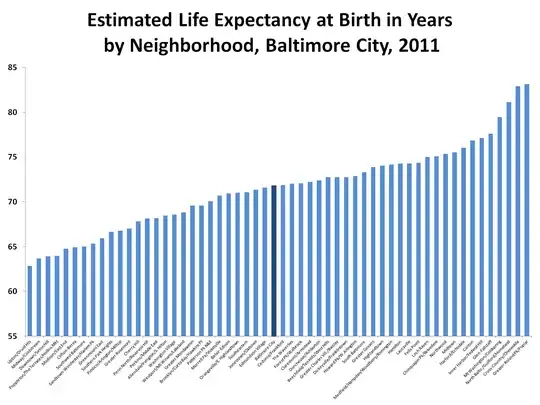Yes, this is true in some west Baltimore neighborhoods.
For example, in the Druid Heights neighborhood, there are few older men. Only 35 out of 1570 (2.2%) are men over the age of 64. Yet 195 (12.4%) are women over 64. (See page 2 here).
(The age data is not broken down by race, but 1520 of 1570 (97%) were black)
For comparison, in the 2010 census, 5.6% of the US population was men over age 64; and 7.4% was women over age 64.
For Harlem Park, only 130 out of 3800 (3.4%) are men over the age of 64. (3780 (99%) are black.) Yet 475 (12.5%) are women over 64. (See page 2 here.)
For Panway, only 10 out of 1380 (0.7%) are men over the age of 64. Yet 125 (9%) are women over 64. (100% were black.) Even looking at the entire adult (over 18) population, only 37% are men. Source
The news story refers to a specific place, adjacent the playing fields of Fredrick Douglass High School. ("I practically lived on the playing fields at Frederick Douglass High School, which became a focal point for the riots.")
The Panway neighborhood discussed above would be about 300 meters to the west of the playing fields. The neighborhood actually containing the school would be the Mondawmin neighborhood. Mondawmin has a very normal 5.6% men over 64 years old (but 14.6% are women over 64). However, only 37% of adults (over 18) are male. See page 2 here.

In Baltimore, depending upon neighborhood, life expectancy varies by over 20 years. Even considering both men and woman together, life expectancy is below 64 years in the Druid Heights neighborhood (at the extreme left in the graph). At the extreme right is the wealthy Roland Park neighborhood. Source of image.
Even more extreme variation is seen looking at mortality rates for young and middle age adults in different Baltimore neighborhoods, in data availible from the Baltimore Neighborhood Indicator Alliance
For example, for ages 25-44, the mortality rate per 10,000 was:
In "Greater Roland Park"
2013: 2.1
2012: 2.1
2011: 3.2
In "Greater Mondawmin" (which would include both Panway and Mondawmin)
2013: 29.3
2012: 38.1
2011: 41.0
In "Upton/Druid Heights"
2013: 34.2
2012: 49.3
2011: 51.7
Unfortunately, these mortality statistics are not broken down by race and sex, but Mondawmin, Upton, and Druid Heights are almost exclusively black neighborhoods. The person interviewed in the story (as well as the reporter who is speaking of his own former neighborhood) has good reason refer to "pine boxes", because an abnormally high number of people do die young in his neighborhood.
As far as the "big numbers" mentioned in the story, the violent crime rate per 1,000 is given by the same source by neighborhood:
In "Greater Roland Park"
2013: 2.3
2012: 2.0
2011: 3.7
In "Greater Mondawmin"
2013: 29.3
2012: 25.3
2011: 22.0
In "Upton/Druid Heights"
2013: 21.9
2012: 28.7
2011: 26.8
